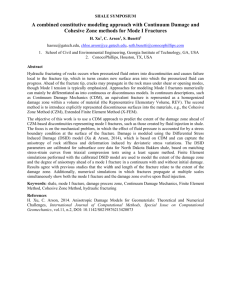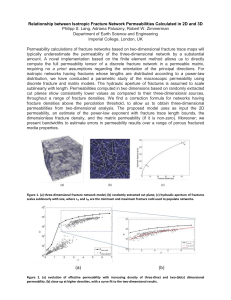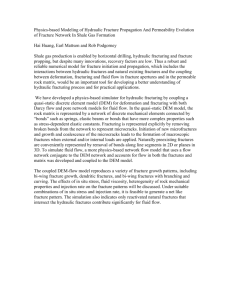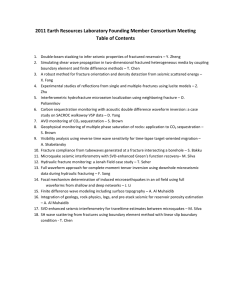Fluid Flow Property Estimation from Seismic Scattering Data
advertisement
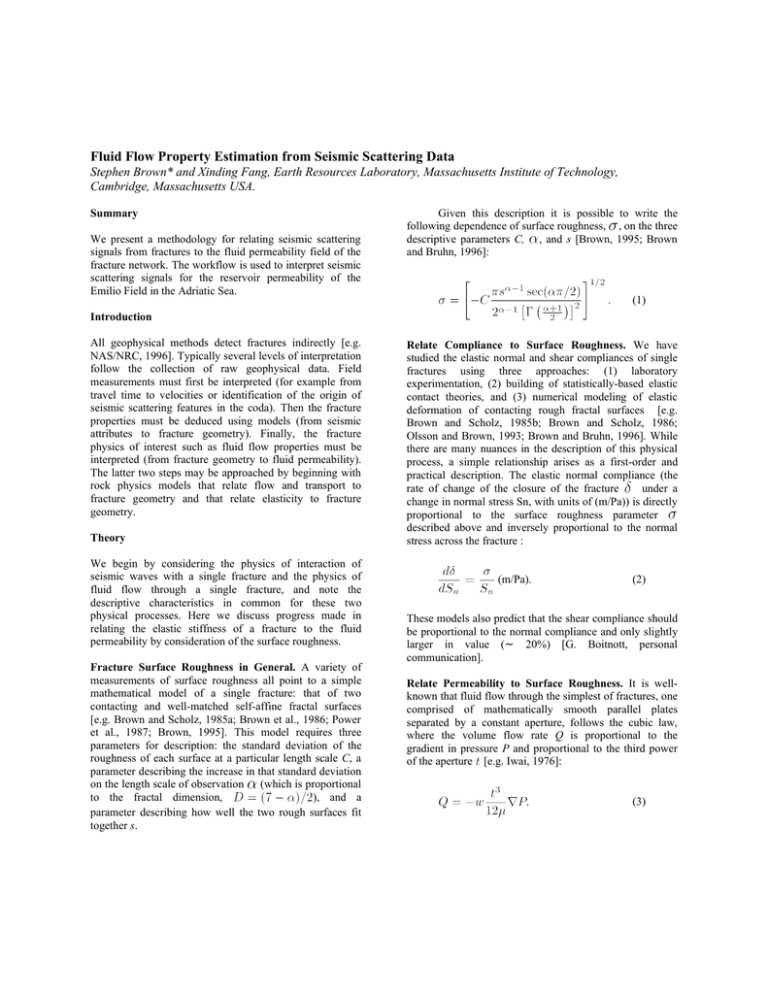
Fluid Flow Property Estimation from Seismic Scattering Data Stephen Brown* and Xinding Fang, Earth Resources Laboratory, Massachusetts Institute of Technology, Cambridge, Massachusetts USA. Summary We present a methodology for relating seismic scattering signals from fractures to the fluid permeability field of the fracture network. The workflow is used to interpret seismic scattering signals for the reservoir permeability of the Emilio Field in the Adriatic Sea. Given this description it is possible to write the following dependence of surface roughness, , on the three descriptive parameters C, , and s [Brown, 1995; Brown and Bruhn, 1996]: (1) Introduction All geophysical methods detect fractures indirectly [e.g. NAS/NRC, 1996]. Typically several levels of interpretation follow the collection of raw geophysical data. Field measurements must first be interpreted (for example from travel time to velocities or identification of the origin of seismic scattering features in the coda). Then the fracture properties must be deduced using models (from seismic attributes to fracture geometry). Finally, the fracture physics of interest such as fluid flow properties must be interpreted (from fracture geometry to fluid permeability). The latter two steps may be approached by beginning with rock physics models that relate flow and transport to fracture geometry and that relate elasticity to fracture geometry. Theory We begin by considering the physics of interaction of seismic waves with a single fracture and the physics of fluid flow through a single fracture, and note the descriptive characteristics in common for these two physical processes. Here we discuss progress made in relating the elastic stiffness of a fracture to the fluid permeability by consideration of the surface roughness. Fracture Surface Roughness in General. A variety of measurements of surface roughness all point to a simple mathematical model of a single fracture: that of two contacting and well-matched self-affine fractal surfaces [e.g. Brown and Scholz, 1985a; Brown et al., 1986; Power et al., 1987; Brown, 1995]. This model requires three parameters for description: the standard deviation of the roughness of each surface at a particular length scale C, a parameter describing the increase in that standard deviation on the length scale of observation (which is proportional to the fractal dimension, ), and a parameter describing how well the two rough surfaces fit together s. Relate Compliance to Surface Roughness. We have studied the elastic normal and shear compliances of single fractures using three approaches: (1) laboratory experimentation, (2) building of statistically-based elastic contact theories, and (3) numerical modeling of elastic deformation of contacting rough fractal surfaces [e.g. Brown and Scholz, 1985b; Brown and Scholz, 1986; Olsson and Brown, 1993; Brown and Bruhn, 1996]. While there are many nuances in the description of this physical process, a simple relationship arises as a first-order and practical description. The elastic normal compliance (the rate of change of the closure of the fracture under a change in normal stress Sn, with units of (m/Pa)) is directly proportional to the surface roughness parameter described above and inversely proportional to the normal stress across the fracture : (m/Pa). (2) These models also predict that the shear compliance should be proportional to the normal compliance and only slightly larger in value (∼ 20%) [G. Boitnott, personal communication]. Relate Permeability to Surface Roughness. It is wellknown that fluid flow through the simplest of fractures, one comprised of mathematically smooth parallel plates separated by a constant aperture, follows the cubic law, where the volume flow rate Q is proportional to the gradient in pressure P and proportional to the third power of the aperture [e.g. Iwai, 1976]: (3) Seismic to Flow For n parallel fractures the flow rates are summed [e.g. Snow, 1968]: (4) Comparing this cubic law to Darcy’s Law, where the term permeability K is defined, yields the permeability of a group of n parallel fractures packed within a zone of a reservoir of thickness T: (5) These expressions have been validated experimentally and numerically and have been found to be applicable, to a good approximation, to the case of rough fractures as well [e.g. Brown, 1987; Brown, 1989; Thompson and Brown, 1991; Olsson and Brown, 1993]. Surface roughness and the resulting tortuosity reduces the permeability only slightly in those cases of clean uncemented fractures under moderate normal stress. Relate Compliance to Permeability. An important firstorder result [ e.g. following Brown and Scholz, 1985; Brown and Scholz, 1986; Olsson and Brown, 1993; Brown, 1995; Brown and Bruhn, 1996] is that at moderate normal stresses, the effective fluid flow aperture t is proportional to the surface roughness parameter described before: (7) This relationship, although it needs to be more carefully researched, is the key to relating fluid permeability to elastic compliance of either a single fracture or to a set of parallel fractures. By substituting t for gives the following relationship between fracture permeability K and elastic normal compliance : (8) There are some similarities between this expression and the empirical results of Pyrak-Nolte and Morris [2000]. General Fabric Tensor Model (Oda's Statistical Fracture Model) In a series of papers, M. Oda and coworkers present a statistical approach to describing and modeling the elastic deformation and fluid flow properties of fractured rock [Oda, 1982; Oda, 1984; Oda, 1985; Oda, 1986; Oda, 1988; Oda et al, 1984; Oda et al, 1986; Oda et al,1987]. In this approach the elastic compliance and permeability properties are related to the fracture geometry through tensors. The tensors for each physical property are derived by taking a volume average of the expected effect of each fracture in the population. The volume average contains functions of the fracture orientation, length, and aperture in such a way that long fractures or wide fractures contribute relatively more than their smaller cousins. In this model elasticity can be implicitly coupled to fluid flow through relationships between fracture aperture and normal stress across the fracture. Fabric Tensor. Oda [1982] envisioned that a general geometric property of fractured rock, termed the fabric, determines many mechanical properties of geological materials. He developed a mathematical description, a fabric tensor, which considers the following elements of fracture geometry: • Position and density of fractures. The position of a fracture is identified by the coordinates of its centroid. The spatial density of fractures is identified as the number of fracture centroids per unit volume. • Orientation, shape and dimension of fractures. A fracture is composed of two surfaces each of which has a unit normal vector n (or -n) describing the orientation in space. The distance between the surfaces is termed the aperture t. Fractures are assumed to have a simple shape, such as a circle in three dimensions or a rectangle in two dimensions which occupies the same surface area as the real fracture. The fracture size is therefore specified by an equivalent diameter r. • Statistics of fractures. A probability density function is used to describe the number of fractures with a diameter in the range r, r+dr with aperture in the range t, t+dt whose unit vectors n are oriented within a small solid angle . The fabric tensor was constructed by considering these features and averaging over all fractures and in each arbitrary direction [Oda, 1982], yielding: (10) The subscript m refers to the maximum value present in the volume. The factor comes from an assumed circular geometry of each fracture in three dimensions. The Seismic to Flow expression is slightly different for the case of rectangular fractures in two dimensions. Oda [1982] shows that is a dimensionless symmetric tensor encompassing several key aspects of fracture geometry. For example, the first invariant of the fracture tensor is related to fracture porosity, and the differences among the principal values of the fracture tensor provide an index of the fracture geometry anisotropy. Oda [1982] also found that the fracture tensor is empirically related to the uniaxial compressive strength and porosity of fractured materials. Fluid Permeability. Oda [1985] further developed a tensor model for the fluid permeability of fractured rock. This model only considers the permeability of a system of fractures embedded in an impermeable matrix. A new assumption required for fluid flow in this derivation requires that the fractures be comprised of smooth parallel plates with a constant separation or aperture t, where the volumetric flow rate is proportional to the aperture raised to the third power ( ). Thus small variations in aperture result in large variations in fluid permeability. Given this assumption, the permeability tensor is found to be (11) where (12) The parameter, , is the Kronnecker delta function. Note the differences between the tensors and with respect to the r and t terms. In (11) and (12) the fluid permeability depends on the statistical distributions of lengths r, apertures t, orientations , and the spatial density of fractures in a network. The parallel plate model is an idealized description of fracture behavior [e.g., Brown, 1989, Brown, 1995]. This is not a severe limitation, however, since more general fracture properties such as surface roughness and tortuosity can be readily included in the software implementation of the model. The issue of fracture interconnectivity arises in this derivation. In the cubic law for flow through a single fracture a pre-multiplying constant of 1/12 appears [e.g., Iwai, 1976]. In Oda's derivation this constant is replaced by the variable ranging between 0 and 1/12 to allow for imperfect interconnectivity of multiple fractures in a network. Oda [1985] discusses how this interconnectivity parameter can be estimated from the fabric tensor (Equation 10) for any particular fracture network. Workflow for Scattering to Permeability We combine the theory relating permeability of a single fracture to elastic normal compliance (Equation 8) with the fracture system permeability tensor results (General Fabric Tensor Model, Equations 11 and 12) to create a workflow relating seismic scattering to reservoir fluid flow properties (Figure 1). An explanation of this workflow follows. Fang et al. [2012] provides a method to describe properties of fractures in a subsurface reservoir using seismic scattering signals. These methods were applied to the Emilio field in the Adriatic Sea. The seismic scattering results consist of: (1) orientation of dominant scatterers (Figure 1a) (2) confidence in orientation (3) relative spacing of parallel fractures in dominant scattering direction (Figure 1b) (4) confidence in spacing (5) relative compliance of fractures in dominant scattering direction (Figure 1c) (6) confidence in compliance These results are used as inputs for the calculations in the workflow. Figure 1 illustrates the main components of the workflow. There are several interpretive steps to transform the scattering results (Figure 1 a,b,c) into a map of reservoir permeability (Figure 1f). The GFT model (Figure 1e, refer also to Equations 11 and 12) requires the following inputs for a set of fractures: (1) fracture orientation, (2) fracture aperture, (3) fracture length, and (4) the relative density of fractures in the set (probability density = number/volume). The scattering results only provide the fracture orientation directly and the other three parameters must be inferred. Implementation and Demonstration of Workflow The fracture fluid flow aperture (Figure 1d) is derived from the fracture permeability to elastic normal compliance relationship (Equation 8). The spatial density of fractures is assumed to be inversely proportional to the spacing. The fracture length is more subjective. A reasonable assumption in the absence of other information is that the fracture length is related to spacing also – that is the larger the spacing between fractures, the greater length the fractures can be. We assume that it is unlikely from the point of view Seismic to Flow of mechanical origins that there will be at the same time very long and very closely spaced fractures. image (Figure 1f) represents only a qualitative description of the permeability on the reservoir. One more subjective feature is included in the workflow. The scattering results represent a volume average of a set of fractures and represent only the properties in the dominant direction. We can reasonably assume that within each scattering volume there is a distribution of fractures with a range of orientations, etc. Therefore in the workflow we use the uncertainty in the scattering orientation as a measure of the relative anisotropy of the fracture distribution in the scattering volume. This uncertainty parameter ranges from 0-1, where 0 represents a single orientation of fractures in the volume and 1 represents a isotropic medium, where there are equal numbers of fractures in all orientations. We use the orientation uncertainty to add a second perpendicular set of fractures to the calculations in the GFT model in which both the aperture and length parameters are scaled linearly by the orientation uncertainty. Conclusions We present a methodology for relating seismic scattering signals from fractures to the fluid permeability field of the fracture network. This workflow was demonstrated using seismic scattering data derived for the Emilio Field following the work of Fang et al. [2012]. As a first step toward practical application, we recommend that this workflow be used as the basis for performing a sensitivity study of the model parameters. In this next step, the seismic scattering results would be used as inputs and the unknown parameters in the model would be varied in a Monte Carlo fashion to see how sensitive the output is to each parameter. This will help define prioritize effort in field data description and interpretation to the most efficient approach. Acknowledgments Figure 1 shows a demonstration of the workflow for the Emilio Field taking the most recent seismic scattering maps as inputs. Since for this demonstration we did not know the specific scaling parameters for the compliance to permeability relationship of Equation 8, the permeability This work was funded by the Eni Multiscale Reservoir Science Project within the Eni-MIT Energy Initiative Founding Member Program. Figure 1: Illustration of the workflow relating seismic scattering to reservoir permeability. The workflow is demonstrated for the Emilio Field [fracture scattering data derived following techniques presented by Fang et al., 2012].

